Experimental Study on Surface Polishing of SLM-316L Stainless Steel via Laser Treatment and Mechanical Grinding
Abstract
1. Introduction
2. Materials and Methods
3. Results and Discussion
3.1. Influence of Laser Processing Parameters on Surface Roughness of SLM-316L Stainless Steel
3.2. Surface Morphology and Material Composition Analysis of SLM-316L Stainless Steel After Laser Processing
3.3. Mechanical Grinding of Laser-Treated 316L Stainless Steel
4. Conclusions
- (1)
- The optimal laser processing parameters are 0.5 mm laser defocusing amount, 14 W laser power, 100 mm/s laser scanning speed, 8 μm laser scanning pitch, and 25 laser scanning times. Under optimal machining parameters, the surface roughness of SLM-316L stainless steel was reduced from 7.912 μm to 1.936 μm.
- (2)
- Deteriorated layers appeared on the surface of the laser-treated stainless steel. EDS and XRD results indicate that the surface metamorphic layer consists of Fe2O3, Fe3O4, and Fe1.67Mo1.33O4. This is due to the oxidation reaction between the metal elements in SLM-316L stainless steel and the oxygen present in the air during the laser polishing process.
- (3)
- The surface of SLM-316L stainless steel after laser processing became flat but had randomly distributed irregular micro-cracks. This phenomenon arises from the presence of inherent defects within the SLM-316L stainless steel. The defects will significantly increase the absorption of laser energy, resulting in a sharp rise in temperature and thermal stress at the defect. This induces the formation of micro-cracks at these defect sites.
- (4)
- After undergoing laser treatment, the surface of the stainless steel underwent oxidation, resulting in the formation of metal oxides. Additionally, numerous micro-cracks, which were randomly distributed, appeared on the surface. These laser-induced surface alterations facilitated the subsequent mechanical grinding process. AFM measurements revealed that the surface roughness of stainless steel after mechanical grinding was about 3 nm. Moreover, the metal oxides and micro-cracks on the stainless steel surface were completely removed during this process.
Author Contributions
Funding
Data Availability Statement
Acknowledgments
Conflicts of Interest
References
- Liu, Y.; Li, Z.; Liu, X.D.; Zhang, W.; Gao, C.F. Electropolishing of selective laser-melted 316L stainless steel. Electroplat. Finish. 2022, 41, 1634–1639. [Google Scholar] [CrossRef]
- Kong, Z.; Wang, X.; Hu, N.; Jin, Y.; Tao, Q.; Xia, W.; Lin, X.-M.; Vasdravellis, G. Mechanical properties of SLM 316L stainless steel plate before and after exposure to elevated temperature. Constr. Build. Mater. 2024, 444, 137786. [Google Scholar] [CrossRef]
- Liverani, E.; Toschi, S.; Ceschini, L.; Fortunato, A. Effect of selective laser melting (SLM) process parameters on microstructure and mechanical properties of 316L austenitic stainless steel. J. Mater. Process. Technol. 2017, 249, 255–263. [Google Scholar] [CrossRef]
- Suryawanshi, J.; Prashanth, K.G.; Ramamurty, U. Mechanical behavior of selective laser melted 316L stainless steel. Mater. Sci. Eng. A 2017, 696, 113–121. [Google Scholar] [CrossRef]
- Huang, Y.; Yang, S.; Gu, J.; Xiong, Q.; Duan, C.; Meng, X.; Fang, Y. Microstructure and wear properties of selective laser melting 316L. Mater. Chem. Phys. 2020, 254, 123487. [Google Scholar] [CrossRef]
- Sun, Z.; Tan, X.; Tor, S.B.; Yeong, W.Y. Selective laser melting of stainless steel 316L with low porosity and high build rates. Mater. Des. 2016, 104, 197–204. [Google Scholar] [CrossRef]
- Bhaduri, D.; Penchev, P.; Batal, A.; Dimov, S.; Soo, S.L.; Sten, S.; Harrysson, U.; Zhang, Z.; Dong, H. Laser polishing of 3D printed mesoscale components. Appl. Surf. Sci. 2017, 405, 29–46. [Google Scholar] [CrossRef]
- Lambarri, J.; Leunda, J.; Soriano, C.; Sanz, C. Laser surface smoothing of nickel-based superalloys. Phys. Procedia 2013, 41, 255–265. [Google Scholar] [CrossRef]
- Lednev, V.N.; Pershin, S.M.; Ionin, A.A.; Kudryashov, S.I.; Makarov, S.V.; Ligachev, A.E.; Rudenko, A.A.; Chmelnitsky, R.A.; Bunkin, A.F. Laser ablation of polished and nanostructured titanium surfaces by nanosecond laser pulses. Spectrochim. Acta Part B At. Spectrosc. 2013, 88, 15–19. [Google Scholar] [CrossRef]
- Chen, G.; Li, J.; Luo, H.M.; Zhou, Y.; Luo, G.H.; Pan, G.S.; Xie, X.Z. Experimental study on 6H silicon carbide silicon-face polished by femtosecond laser. Mech. Eng. Technol. 2020, 9, 180. [Google Scholar] [CrossRef]
- Gisario, A.; Barletta, M.; Veniali, F. Laser polishing: A review of a constantly growing technology in the surface finishing of components made by additive manufacturing. Int. J. Adv. Manuf. Technol. 2022, 120, 1433–1472. [Google Scholar] [CrossRef]
- Liu, E.; Xu, J.; Chen, X.; Chen, Y.; Shan, D.; Guo, B. Advancements and developments of laser polishing technology. Chin. J. Laser 2023, 50, 100–118. [Google Scholar] [CrossRef]
- Dai, W.; Zheng, Z.; Li, J.; Huang, Q.; Liu, J. Research progress of laser polishing on the metal surface. Laser Optoelectron. Prog. 2015, 52, 7–20. [Google Scholar] [CrossRef]
- Chen, B.; Sun, S.; Wang, Q.; Zhang, Y.; Shao, Y.; Zhang, L.; Zhao, D.; Wang, P.; Chen, X.; Liu, J.; et al. Research progress of laser polishing technology for material surface. China Surf. Eng. 2021, 34, 74–89. [Google Scholar] [CrossRef]
- Pfefferkorn, F.E.; Duffie, N.A.; Morrow, J.D.; Wang, Q. Effect of beam diameter on pulsed laser polishing of S7 tool steel. CIRP Ann. 2014, 63, 237–240. [Google Scholar] [CrossRef]
- Ukar, E.; Lamikiz, A.; López de Lacalle, L.N.; del Pozo, D.; Arana, J. Laser polishing of tool steel with CO2 laser and high-power diode laser. Int. J. Mach. Tools Manuf. 2010, 50, 115–125. [Google Scholar] [CrossRef]
- Avilés, R.; Albizuri, J.; Lamikiz, A.; Ukar, E.; Avilés, A. Influence of laser polishing on the high cycle fatigue strength of medium carbon AISI 1045 steel. Int. J. Fatigue 2011, 33, 1477–1489. [Google Scholar] [CrossRef]
- Zhao, Z.Y.; Zhang, Z.J.; Yin, B.; Xu, X.M. Experimental study on nanosecond laser polishing die steel S136D. In Proceedings of the IOP Conference Series: Materials Science and Engineering, Suzhou, China, 17–19 March 2021; IOP Publishing: Bristol, UK, 2020; Volume 758, p. 012037. [Google Scholar]
- Guo, K.W. Effect of polishing parameters on the morphology of DF2 (AISI-O1) steel surface polished by Nd: YAG laser. Surf. Eng. 2009, 25, 187–195. [Google Scholar] [CrossRef]
- Zhou, Y.; Zhao, Z.; Zhang, W.; Xiao, H.; Xu, X. Experiment study of rapid laser polishing of freeform steel surface by dual-beam. Coatings 2019, 9, 324. [Google Scholar] [CrossRef]
- Zeng, J.; Zhao, Z.; Lou, Y.; Li, K.; Yin, J.; Wang, C. Experimental research on nanosecond laser polishing TC4. J. Shenzhen Inst. Inf. Technol. 2022, 20, 57–62. [Google Scholar]
- Perry, T.L.; Werschmoeller, D.; Li, X.; Pfefferkorn, F.E.; Duffie, N.A. Pulsed laser polishing of micro-milled Ti6Al4V samples. J. Manuf. Process. 2009, 11, 74–81. [Google Scholar] [CrossRef]
- Liang, C.; Hu, Y.; Liu, N.; Zou, X.; Wang, H.; Zhang, X.; Fu, Y.; Hu, J. Laser polishing of Ti6Al4V fabricated by selective laser melting. Metals 2020, 10, 191. [Google Scholar] [CrossRef]
- Li, J.; Yang, Y.; Jin, W.; Zeng, Z.; Yan, S. Error remapping of surface morphology by laser polishing. Surf. Technol. 2020, 49, 309–315. [Google Scholar] [CrossRef]
- Chen, L.; Richter, B.; Zhang, X.; Bertsch, K.B.; Thoma, D.J.; Pfefferkorn, F.E. Effect of laser polishing on the microstructure and mechanical properties of stainless steel 316L fabricated by laser powder bed fusion. Mater. Sci. Eng. A 2021, 802, 140579. [Google Scholar] [CrossRef]
- Hong, J.; Qian, Y.; Zhang, L.; Huang, H.; Jiang, M.; Yan, J. Laser nitriding of Zr-based metallic glass: An investigation by orthogonal experiments. Surf. Coat. Technol. 2021, 424, 127657. [Google Scholar] [CrossRef]
- Zhou, H.; Zhou, H.; Zhao, Z.; Li, K.; Yin, J. Numerical simulation and verification of laser-polishing free surface of S136D die steel. Metals 2021, 11, 400. [Google Scholar] [CrossRef]
- Huang, X.; Wang Tao Hu, S.; Yao, T.; Miao, R.P.; Kang, Q.C.; Zhang, Y.Z. Parameter optimization of laser polishing based on orthogonal experiment and response surface method. Laser Optoelectron. Prog. 2022, 11, 1114004. [Google Scholar] [CrossRef]
- Zhai, J.; Zhang, Q.; Zhu, Y. Picosecond laser ablation of polycrystalline CVD diamond. Opt. Laser Technol. 2022, 155, 108403. [Google Scholar] [CrossRef]
- Liu, N.; Lei, L.; Zhu, J.; Lu, H.; Xiao, J.; Zhang, J.; Chen, X.; Xu, J.; Yamamura, K. An interior damage free approach for nanosecond pulsed laser ablation of single crystal diamond via metal film induced self-maintaining graphitization. J. Manuf. Process. 2024, 131, 958–972. [Google Scholar] [CrossRef]
- Wang, Z.; Yang, S.; Huang, Y.; Fan, C.; Peng, Z.; Gao, Z. Microstructure and fatigue damage of 316L stainless steel manufactured by selective laser melting (SLM). Materials 2021, 14, 7544. [Google Scholar] [CrossRef]
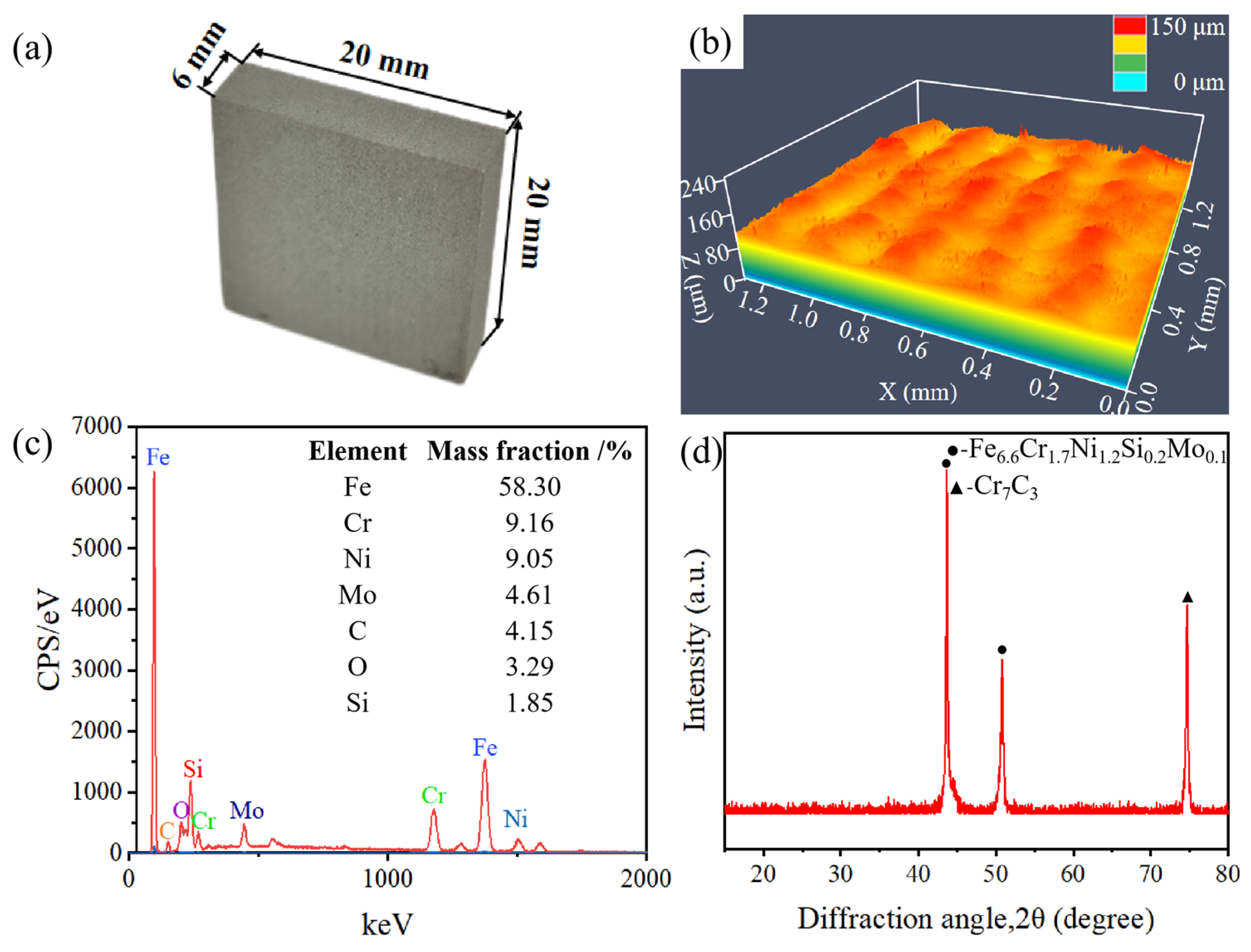
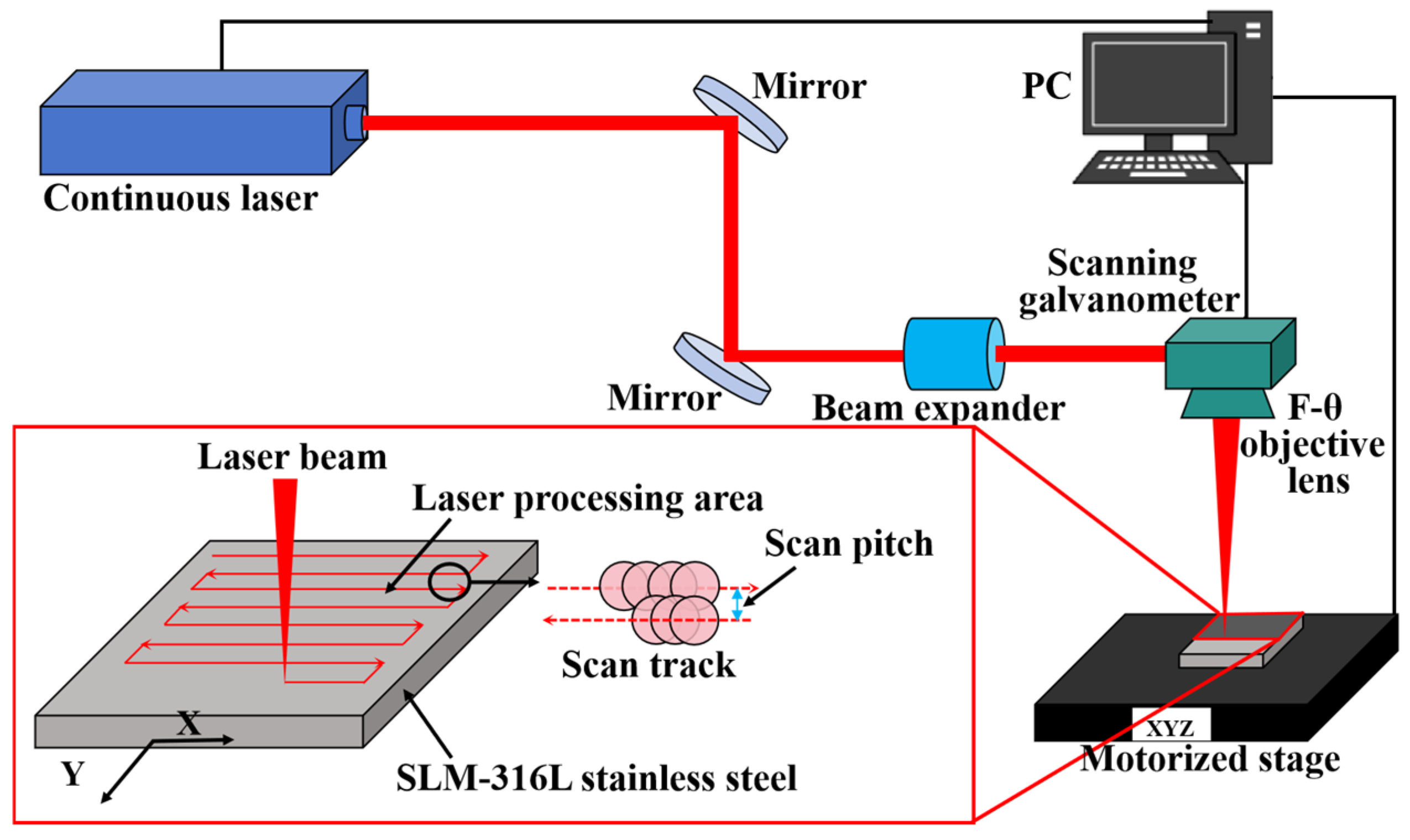

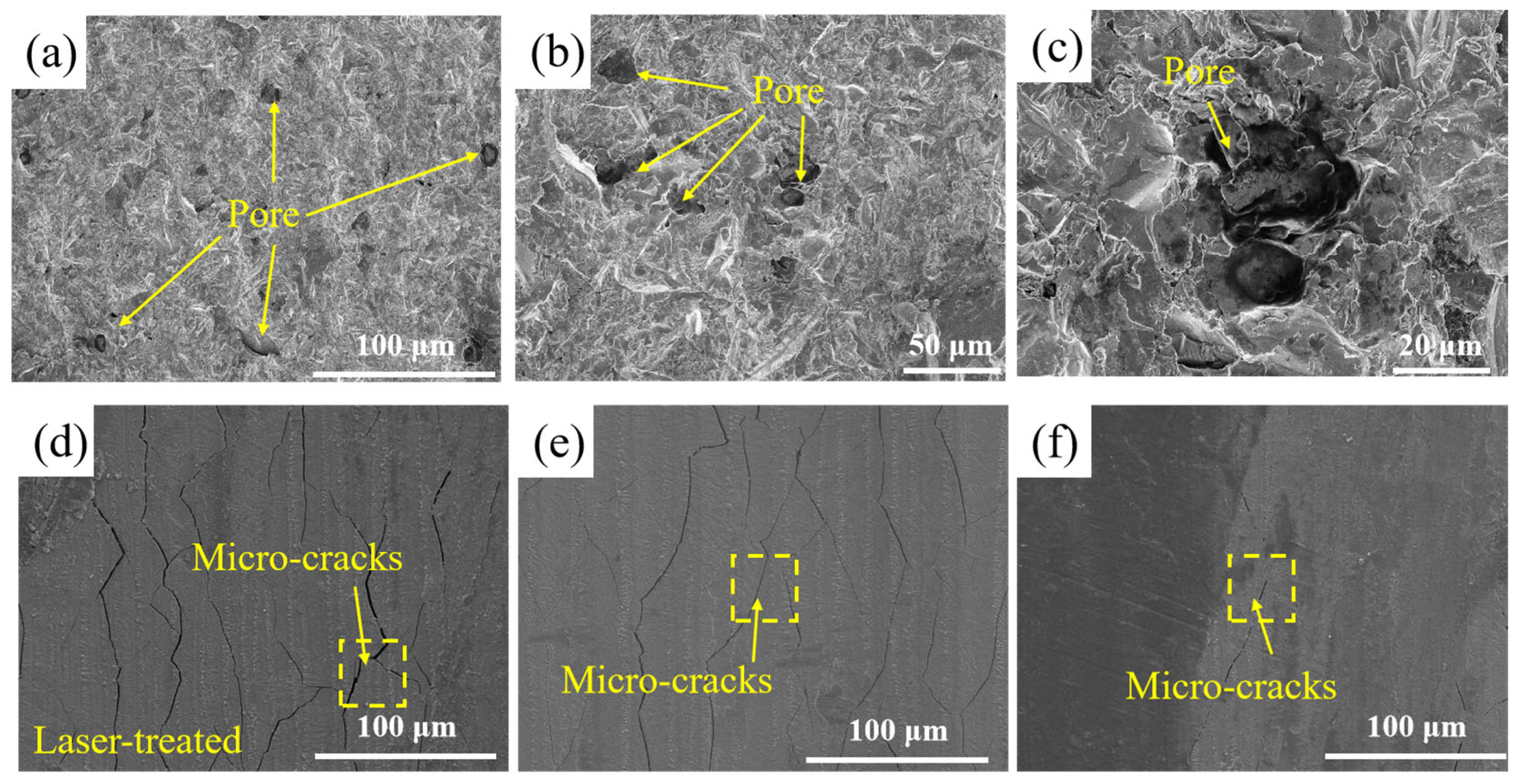
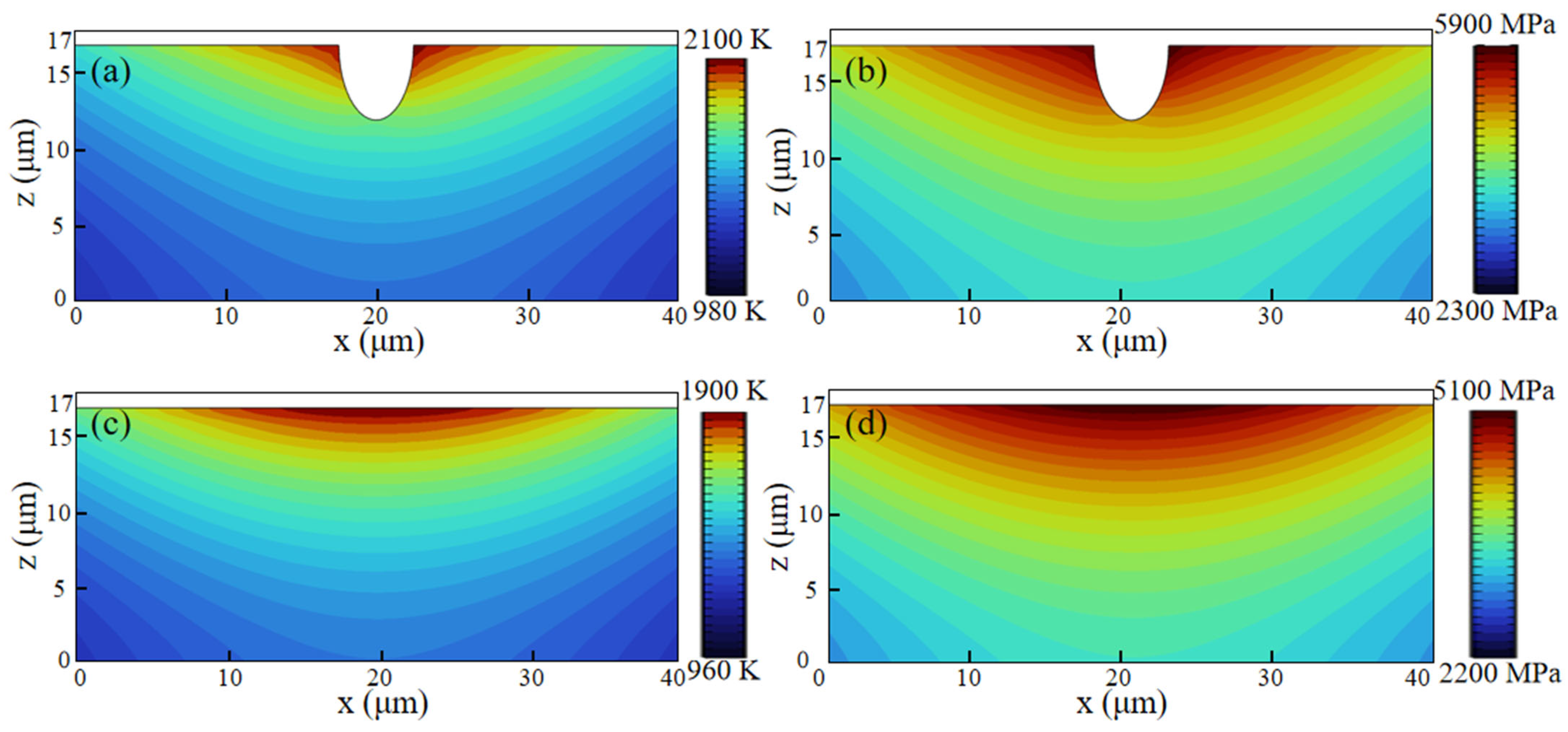
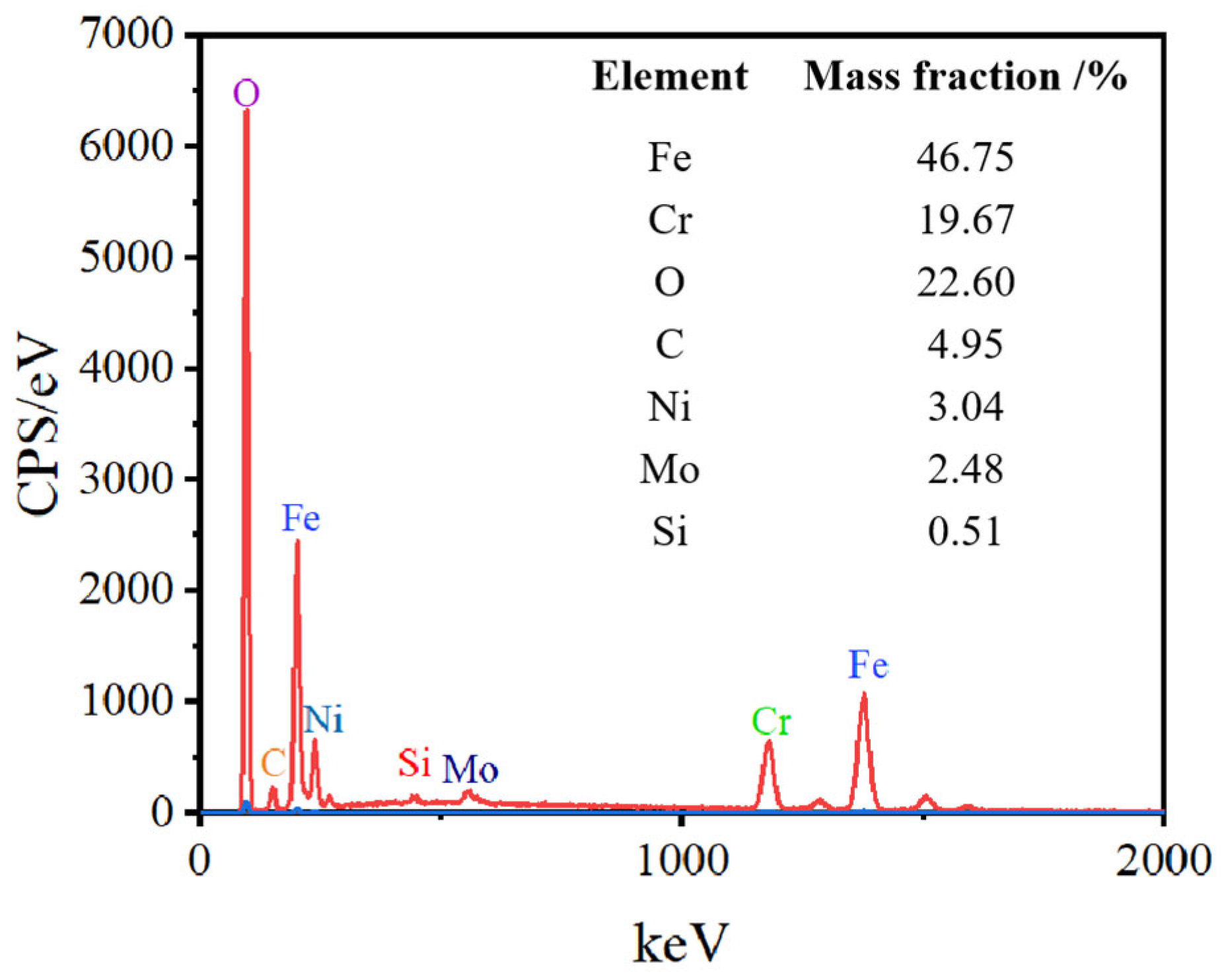

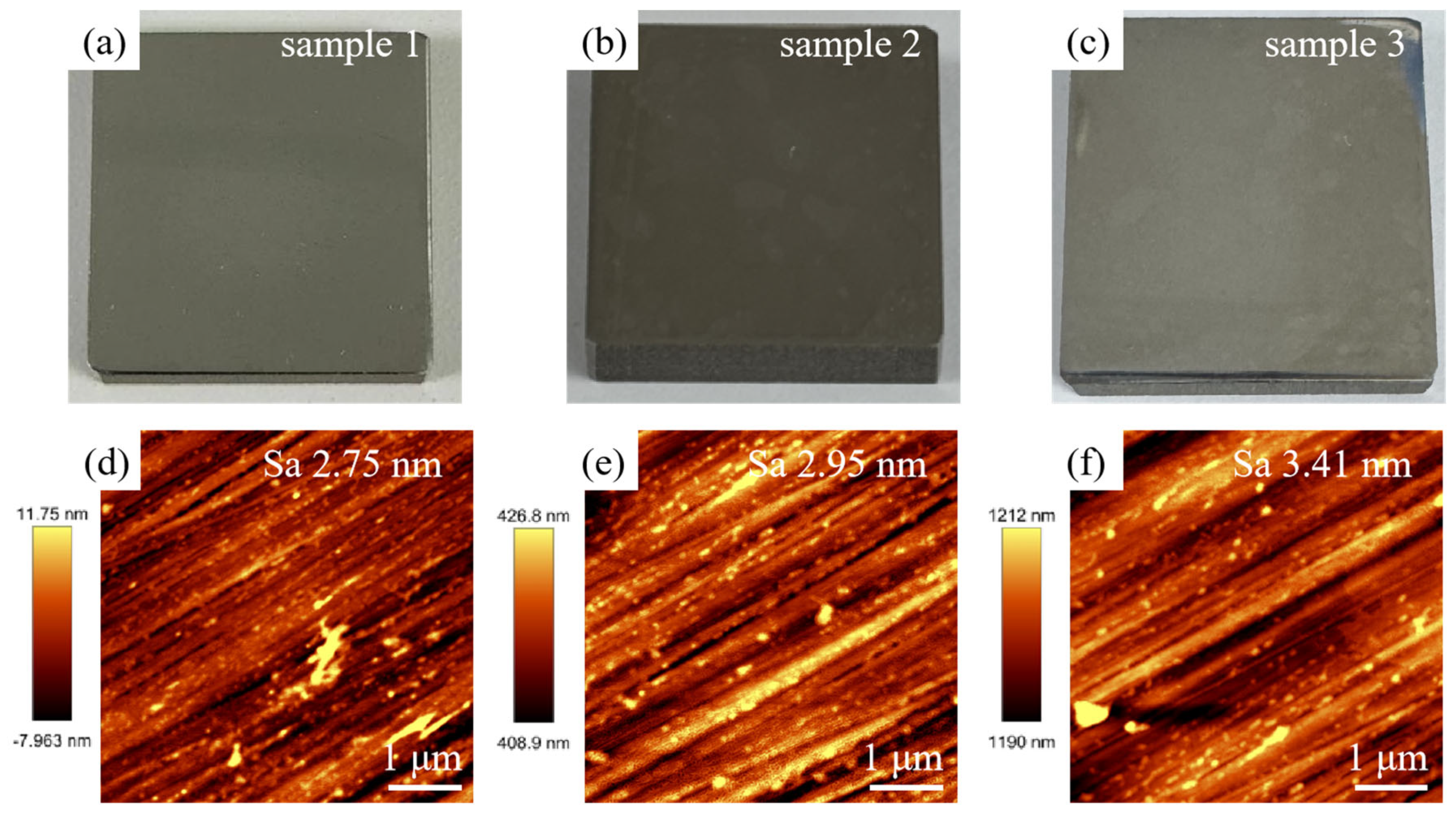
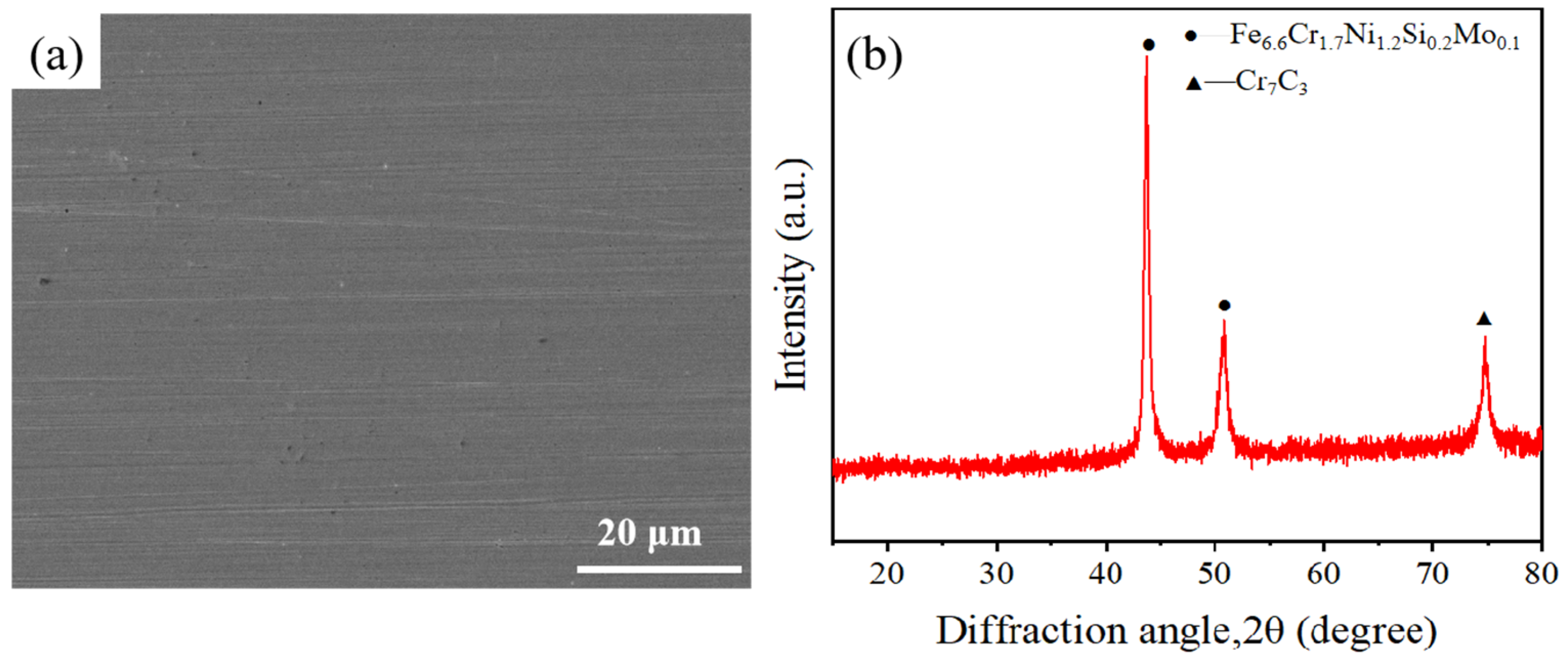
| Factors | Level 1 | Level 2 | Level 3 | Level 4 |
|---|---|---|---|---|
| H/mm | 0 | 0.5 | 1 | 1.5 |
| P/W | 8 | 10 | 12 | 14 |
| S | 15 | 20 | 25 | 30 |
| V/(mm/s) | 75 | 100 | 125 | 150 |
| D/μm | 8 | 10 | 12 | 14 |
| Expt. No. | H/mm | P/W | S | V/(mm∙s−1) | D/μm | Average Roughness/μm |
|---|---|---|---|---|---|---|
| 1 | 0 | 8 | 15 | 75 | 8 | 4.003 |
| 2 | 0 | 10 | 20 | 100 | 10 | 2.749 |
| 3 | 0 | 12 | 25 | 125 | 12 | 2.630 |
| 4 | 0 | 14 | 30 | 150 | 14 | 2.637 |
| 5 | 0.5 | 8 | 20 | 125 | 14 | 6.596 |
| 6 | 0.5 | 10 | 15 | 150 | 12 | 3.673 |
| 7 | 0.5 | 12 | 30 | 75 | 10 | 3.502 |
| 8 | 0.5 | 14 | 25 | 100 | 8 | 1.936 |
| 9 | 1 | 8 | 25 | 150 | 10 | 6.178 |
| 10 | 1 | 10 | 15 | 125 | 8 | 7.259 |
| 11 | 1 | 12 | 30 | 100 | 14 | 7.123 |
| 12 | 1 | 14 | 20 | 75 | 12 | 2.657 |
| 13 | 1.5 | 8 | 30 | 100 | 12 | 5.745 |
| 14 | 1.5 | 10 | 25 | 75 | 14 | 7.337 |
| 15 | 1.5 | 12 | 20 | 150 | 8 | 5.671 |
| 16 | 1.5 | 14 | 15 | 125 | 10 | 5.898 |
| Parameter | H/mm | P/W | S | V/(mm∙s−1) | D/μm |
|---|---|---|---|---|---|
| K1 | 3.004 | 5.631 | 5.208 | 4.375 | 4.717 |
| K2 | 3.297 | 5.255 | 4.418 | 4.388 | 4.582 |
| K3 | 5.804 | 4.732 | 4.520 | 5.596 | 3.676 |
| K4 | 6.163 | 3.282 | 4.752 | 4.540 | 5.923 |
| R | 3.159 | 2.349 | 0.79 | 1.221 | 2.247 |
| Source | SS | df | MS | F | Reliability |
|---|---|---|---|---|---|
| H | 12.793 | 3 | 4.264 | 0.230 | Significant |
| P | 9.099 | 3 | 3.033 | 0.162 | Significant |
| S | 1.462 | 3 | 0.487 | 0.026 | |
| V | 4.135 | 3 | 1.378 | 0.074 | |
| D | 10.206 | 3 | 3.402 | 0.184 | Significant |
| Total | 37.695 | 15 |
| Physical Properties of Materials | |
|---|---|
| Thermal conductivity | 24.55 W/(m·K) |
| Density | 7650 kg/m3 |
| Constant pressure heat capacity | 770.2 J/(kg·K) |
| Modulus of elasticity | 193 GPa |
| Coefficient of thermal expansion | 1.7 × 10−5 (1/K) |
Disclaimer/Publisher’s Note: The statements, opinions and data contained in all publications are solely those of the individual author(s) and contributor(s) and not of MDPI and/or the editor(s). MDPI and/or the editor(s) disclaim responsibility for any injury to people or property resulting from any ideas, methods, instructions or products referred to in the content. |
© 2025 by the authors. Licensee MDPI, Basel, Switzerland. This article is an open access article distributed under the terms and conditions of the Creative Commons Attribution (CC BY) license (https://creativecommons.org/licenses/by/4.0/).
Share and Cite
Fang, W.; Wen, Q.; Hu, J.; Jiang, F.; Hu, Z.; Wu, X.; Yang, J.; Wang, X. Experimental Study on Surface Polishing of SLM-316L Stainless Steel via Laser Treatment and Mechanical Grinding. Micromachines 2025, 16, 634. https://doi.org/10.3390/mi16060634
Fang W, Wen Q, Hu J, Jiang F, Hu Z, Wu X, Yang J, Wang X. Experimental Study on Surface Polishing of SLM-316L Stainless Steel via Laser Treatment and Mechanical Grinding. Micromachines. 2025; 16(6):634. https://doi.org/10.3390/mi16060634
Chicago/Turabian StyleFang, Wei, Qiuling Wen, Jiaxin Hu, Feng Jiang, Zhongwei Hu, Xian Wu, Jinlin Yang, and Xiaoguang Wang. 2025. "Experimental Study on Surface Polishing of SLM-316L Stainless Steel via Laser Treatment and Mechanical Grinding" Micromachines 16, no. 6: 634. https://doi.org/10.3390/mi16060634
APA StyleFang, W., Wen, Q., Hu, J., Jiang, F., Hu, Z., Wu, X., Yang, J., & Wang, X. (2025). Experimental Study on Surface Polishing of SLM-316L Stainless Steel via Laser Treatment and Mechanical Grinding. Micromachines, 16(6), 634. https://doi.org/10.3390/mi16060634









